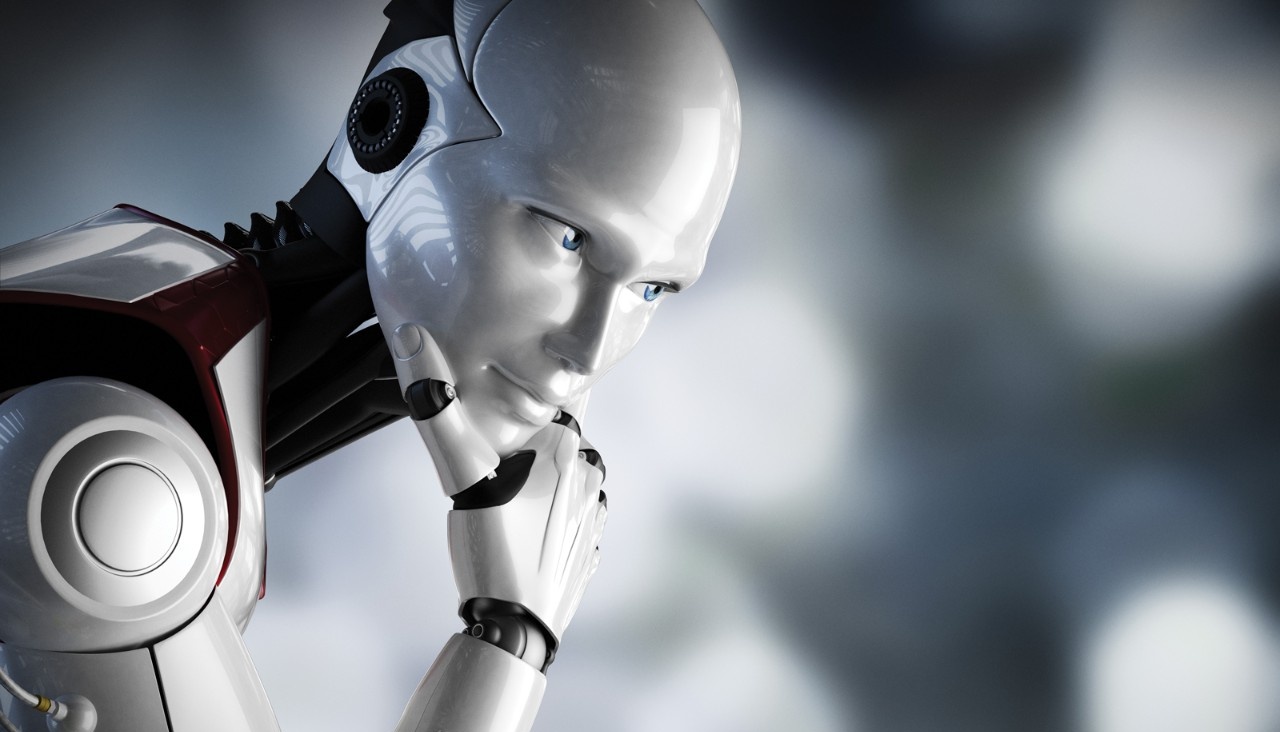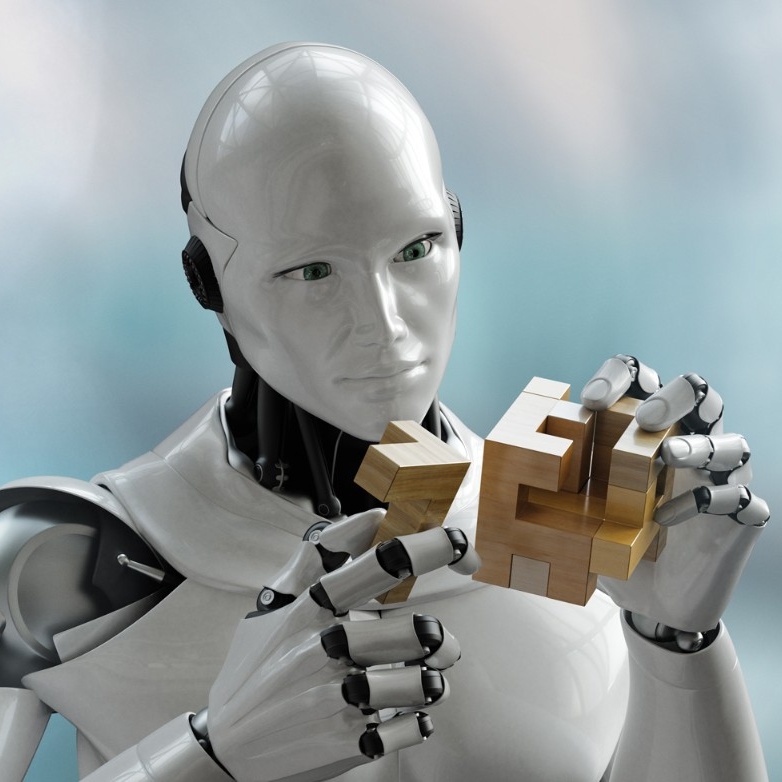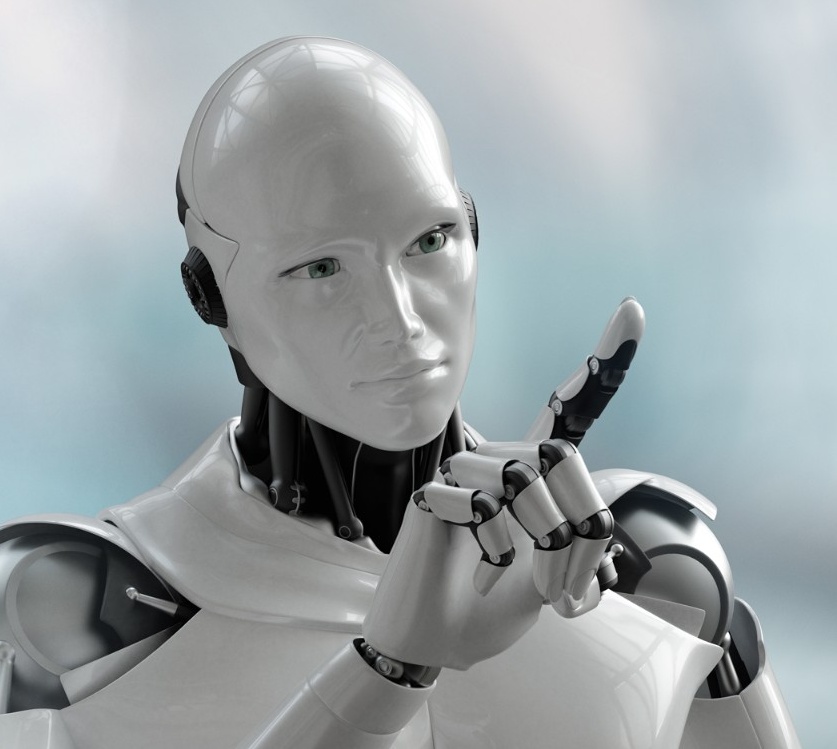Management and the machine
How artificial intelligence is calculating the future of business
By Kevin Manne

Discussions of artificial intelligence (AI) often evoke references to pop-culture science fiction creations like the murderous Skynet from “Terminator” or the humanoid robot C-3PO from “Star Wars.”
And while some of the science fiction is becoming reality, like AI-powered weaponry under development in the U.S. Department of Defense, the ultimate goal of AI has yet to be achieved: to create a computer mind that can think like a human.
However, simple AI systems have been around for years, doing specific tasks better than any human ever could. These narrow AI applications have wide-reaching practical implications throughout all functions of business.
Sanjukta Das Smith, associate professor of management science and systems, says it’s becoming commonplace for companies to use AI to make business decisions based on the huge amount of data they generate and collect.
“With artificial intelligence, businesses can analyze amounts of information that would otherwise be impossible for humans to process,” says Smith. “This allows firms to stock shelves more efficiently, hire employees who better fit their roles, match customers with the products they want and even help you decide where to invest your money.”
Not-so human resources
In the early days of the internet, online job boards like Monster and CareerBuilder rose in popularity, allowing recruiters to attract more applicants than ever. Today, job seekers can also find leads on company websites, LinkedIn, Facebook and specialty job boards.
The high volume of applicants created a new challenge for HR professionals: how to narrow down the pool to the most qualified candidates.
At McDonald’s, a restaurant manager typically oversees 50-60 employees, and the turnover rate is anywhere from 80 to 150 percent. That means, on average, a manager hires someone new every week.
According to Richard Floersch, BS ’80, MBA ’80, retired executive vice president and chief human resources officer of McDonald’s Corp., AI can help identify candidates who are up to the challenge of working in a fast-paced restaurant environment.

“Traditionally, if you got 50 applicants for an open position, you’d narrow that to about half, then spend hours conducting interviews on the phone and in person,” says Floersch. “Artificial intelligence can get you to the top five to seven. The time savings, as well as the higher predictive ability to hire people who will work effectively in the restaurant, is significant.”
AI-powered recruiting assistants like Mya, a chatbot launched by job search firm FirstJob in July, aim to automate and streamline up to 75 percent of the recruitment process, freeing up time so HR professionals can focus on adding strategic business value.
Through a text message-style interface, Mya uses AI and natural language processing to ask questions, verify qualifications and answer questions from applicants about company culture and benefits.
According to Muriel Anderson, clinical associate professor of organization and human resources, 85 percent of applicants never hear back from a recruiter after they apply for a job. Bots like Mya keep candidates updated throughout the hiring process, and early trials found that applicants who engaged with the bot were three times more likely to hear back from a recruiter or hiring manager.
“Mya can pinpoint skills candidates may be missing and give them a chance to make a case for why they should be considered for the job — that’s something that isn’t possible when you just submit an application online,” says Anderson. “We’re now able to have conversations with candidates before we even make the decision about an interview.”
Real-time marketing
In an increasingly digital world, connected devices are becoming ubiquitous. With the wide availability of broadband internet access, the “internet of things” is connecting more devices than ever, including washing machines, thermostats, coffee makers, lamps, watches, navigation systems and almost everything else you can think of.
Analyst firm Gartner predicts that there will be more than 26 billion connected devices by 2020, all of which produce data that companies use to learn more about customers and tailor their marketing to individual behaviors and interests.
“Artificial intelligence gives marketers the ability to anticipate specific customer needs and subsequently inform, target and perform a variety of consumer tasks in real time, while individuals are on the go,” says Charles Lindsey, associate professor of marketing.

In the future, this intersection of big data and AI may give customers the ability to make purchases automatically as they pass by a store, effortlessly order ahead or remotely monitor the line at a restaurant, or receive highly customized, geographically specific brand and product offers while on the move.
Shoaib Alam, BS ’10, is a solutions consultant for Adobe Marketing Cloud, where he’s applying some of these strategies today.
He says Adobe’s business intelligence algorithms ingest data from digital marketing channels and correlate that data with purchases, video views and social media shares to determine what users like to see on websites and how marketing messages or products are performing.
“When you’re playing games and interacting with apps on your game consoles and on-demand platforms, the systems pick up information about what you’re doing,” says Alam. “So if you’re watching Hulu or news shows, it will offer recommendations of other shows, games and nearby events it thinks you may be interested in.”
Streamlining supply chains
For years, airlines and hotels have increased prices during high-demand times.
Now, thanks to artificial intelligence, the practice of “dynamic” or “surge” pricing is expanding to more industries than ever. Fares for ride-sharing services Uber and Lyft increase during peak times, ticket prices for sporting events change in real time based on demand, and even Walt Disney Co. has implemented a new policy that reduces park admission prices on low-demand days and boosts fees during more popular times.
“Artificial intelligence is revolutionizing the retail end of supply chains because it allows businesses to respond in real time to maximize revenue based on unfolding demand,” says Nallan Suresh, UB Distinguished Professor and chair of the Operations Management and Strategy Department.
In supply chain management, AI can uncover buying patterns by digging through huge amounts of sales data, allowing businesses to better understand what customers are looking for and stock items appropriately.

“One of the biggest sources of waste is having too much or not enough product for sale,” says Suresh. “When you’re overstocked, you have to put a sale sign up and take a huge loss. When you underestimate, the customer walks away unfulfilled and that’s a loss in revenue and for the image of the company.”
During the 2012 holiday season, internet retail giant Amazon saw a big surge in orders — so many that traditional carriers like the U.S. Postal Service, UPS and FedEx were unable to deliver many packages on time.
That season pushed Amazon to kick-start Amazon Logistics, its own delivery service that uses big data and AI to increase the speed and efficiency of package delivery. The company has assembled a fleet of delivery trucks, built robot-powered warehouses and partnered with small carriers to transport packages from distribution centers to the end customer, all to add capacity on top of the existing third-party shippers.
“Drones are a perfect example of how we’re shifting energy toward innovation,” says Nida Beig, MS ’15, program manager at Amazon. “AI, data analytics and data scientists have all been pivotal in helping us make effective, efficient decisions to stick to our biggest leadership principle: customer obsession.”

The future of finance
The bots are conquering finance, too. At Charles Schwab, a robo-advisor known as Schwab Intelligent Portfolios will use an algorithm to decide where investors should place their money based on the answers to a short questionnaire. It also manages the portfolios on a daily basis.
In addition, the firm recently announced Schwab Intelligent Advisory, a robo-hybrid service that combines digital advice with a team of professional investment advisors. It’s the latest such service in a growing trend that puts Schwab in direct competition with Vanguard’s Personal Advisor Services and Personal Capital.
Michael Brace, MBA ’94, senior portfolio manager at Courier Capital, says these robo-advisors are great for smaller clients who want better portfolio management without high fees.
Brace says AI investing isn’t a fit for his clients, though, because they value a personal connection.
“People are as emotional as they are quantitative,” says Brace. “It’s about trust. If my clients don’t trust me, it doesn’t matter how well I do performance-wise, they’ll always be wondering if I’m the right person to run their money. You can’t build trust with a computer, and you can’t build trust with a guy in Iowa over the phone, even if you know his name.”

Brian Wolfe, assistant professor of finance, says AI has changed the way we trade stocks, but with some risk.
“The speed that comes with the use of AI and algorithmic trading is a double-edged sword,” says Wolfe. “It can make markets more efficient by helping us get a better sense of what a stock should be priced, but when code is running to make automatic trades, there’s a possibility of trading, say, 100,000 stocks instead of 10,000 — something that would never happen between two human traders face to face.”
Proceed with caution
Artificial intelligence can work 24 hours a day, seven days a week. It doesn’t have to sleep or take a break, doesn’t get bored with repetitive work, and makes decisions faster and using more information than humans are capable of.
With all these benefits, though, experts say challenges lie ahead. According to Shoaib Alam from Adobe, privacy is top of mind for technology firms.
“Privacy is big. We want to be sure that when data is picked up, it’s all anonymous — nothing connected to a particular user,” says Alam. “You’re balancing the ability to get information about users and giving them the right experience, but at the same time protecting them and making sure there is no abuse of that data.”
When Donald Trump won the 2016 U.S. presidential election, many Hillary Clinton supporters were left stunned. According to Sanjukta Das Smith, sites like Facebook may be partially to blame because of how they use AI to personalize what we see. As a result, Clinton backers had news feeds filled with #ImWithHer, not realizing they were seeing tunnel vision.

“In social media, we see a lot of overt and even hidden uses of AI — some positive and some not so positive,” says Smith. “Algorithms mine our engagement, conducting deep sentiment analysis on what we post, how we interact and what we spend time on. All of that feeds other algorithms that drive what we see and what we don’t see, creating an echo chamber effect.”
Possibly the biggest concern with AI is that jobs once performed by humans will someday be taken over by robots or computers that automate these tasks. According to a 2016 report released by market research company Forrester, robots will eliminate 6 percent of all jobs in the U.S. by 2021, starting with customer service representatives and eventually truck and taxi drivers.
However, Smith says that while businesses will use AI in repetitive, administrative support roles, we’re not all doomed to a dystopian future in service to our robot overlords.
“AI will certainly shape how we operate in this world, but we cannot expect an algorithm to replace a human — that’s not going to happen,” says Smith. “What we work on and how much time we spend on repetitive tasks will shift, but creativity, innovation and judgment will always be dictated by a human being.”
Sci-fi becomes reality — artificial intelligence milestones
1950
- Isaac Asimov publishes I, Robot, a collection of short stories with a vision of robots and artificial intelligence that inspires a generation of scientists.
- Alan Turing develops the Turing Test, in which an evaluator tries to determine which of two partners in a conversation is a computer and which is human.
1956
- Computer scientist John McCarthy coins the term “artificial intelligence” for a summer conference at Dartmouth College.
1968
- Stanley Kubrick’s “2001: A Space Odyssey” debuts in theaters. The film features HAL 9000, an intelligent computer that controls the systems of the Discovery One spacecraft and interacts with the ship’s crew.
1966
- Stanford Research Institute creates Shakey, the first robot that can perceive and reason about its surroundings.
1981
- The first successful commercial expert system, the RI, begins operation at Digital Equipment Corp. The system helps configure orders for new computer systems and saves the company $40 million per year.
1997
- IBM-built supercomputer Deep Blue faces off against world chess champion Garry Kasparov — and wins.
2002
- iRobot releases Roomba, an autonomous vacuum cleaner that is the first commercially successful robot for the home.
2009
- Google begins testing self-driving vehicle technology with a Toyota Prius on freeways in California.
2011
- IBM’s Watson faces off against Ken Jennings and Brad Rutter on Jeopardy. Watson easily defeats its two human opponents, the show’s all-time best performers.
Source: Adapted from “AI: 15 key moments in the story of artificial intelligence,” BBC, 2014 bbc.co.uk/timelines/zq376fr
